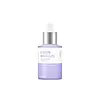What's inside
What's inside
 Key Ingredients
Key Ingredients

 Benefits
Benefits

 Concerns
Concerns

 Ingredients Side-by-side
Ingredients Side-by-side

Lactobacillus/Soybean Ferment Extract
Skin ConditioningBifida Ferment Lysate
Skin ConditioningLactobacillus Ferment Lysate
Skin ConditioningLactococcus Ferment Lysate
Skin ConditioningButylene Glycol
HumectantGlycerin
Humectant1,2-Hexanediol
Skin ConditioningMethyl Gluceth-10
EmulsifyingNiacinamide
SmoothingCitrus Aurantium Bergamia Fruit Oil
MaskingPogostemon Cablin Leaf Oil
MaskingCitrus Aurantium Dulcis Peel Oil
MaskingCentella Asiatica Leaf Extract
Skin ConditioningPolymnia Sonchifolia Root Juice
Skin ConditioningPanthenol
Skin ConditioningPolyglyceryl-10 Laurate
Skin ConditioningDiphenyl Dimethicone
EmollientTromethamine
BufferingTriethylhexanoin
MaskingWater
Skin ConditioningEthylhexylglycerin
Skin ConditioningAdenosine
Skin ConditioningHydrogenated Lecithin
EmulsifyingAlpha-Glucan Oligosaccharide
CleansingMadecassoside
AntioxidantAsiaticoside
AntioxidantMaltodextrin
AbsorbentTocopherol
AntioxidantLactobacillus
Skin ConditioningCarbomer
Emulsion StabilisingLimonene
PerfumingLinalool
PerfumingLactobacillus/Soybean Ferment Extract, Bifida Ferment Lysate, Lactobacillus Ferment Lysate, Lactococcus Ferment Lysate, Butylene Glycol, Glycerin, 1,2-Hexanediol, Methyl Gluceth-10, Niacinamide, Citrus Aurantium Bergamia Fruit Oil, Pogostemon Cablin Leaf Oil, Citrus Aurantium Dulcis Peel Oil, Centella Asiatica Leaf Extract, Polymnia Sonchifolia Root Juice, Panthenol, Polyglyceryl-10 Laurate, Diphenyl Dimethicone, Tromethamine, Triethylhexanoin, Water, Ethylhexylglycerin, Adenosine, Hydrogenated Lecithin, Alpha-Glucan Oligosaccharide, Madecassoside, Asiaticoside, Maltodextrin, Tocopherol, Lactobacillus, Carbomer, Limonene, Linalool
Water
Skin ConditioningKaolin
AbrasiveSodium Cocoyl Glycinate
CleansingGlycerin
HumectantBentonite
AbsorbentMyristic Acid
CleansingPotassium Hydroxide
BufferingLauric Acid
CleansingStearic Acid
CleansingDipropylene Glycol
Humectant1,2-Hexanediol
Skin ConditioningArtemisia Annua Extract
MaskingBambusa Arundinacea Stem Powder
AbrasiveGlycol Distearate
EmollientTitanium Dioxide
Cosmetic ColorantCentella Asiatica Extract
CleansingFicus Carica Fruit Extract
HumectantUlmus Davidiana Root Extract
Skin ConditioningAmaranthus Caudatus Seed Extract
Skin ConditioningLavandula Angustifolia Oil
MaskingCitrus Nobilis Peel Oil
MaskingJuniperus Virginiana Oil
MaskingRosmarinus Officinalis Leaf Oil
MaskingCitrus Aurantium Dulcis Peel Oil
MaskingHydrogenated Lecithin
EmulsifyingMagnesium Aluminum Silicate
AbsorbentChromium Oxide Greens
Artemisia Montana Leaf Powder
ExfoliatingDisodium EDTA
Butylene Glycol
HumectantCeramide NP
Skin ConditioningHydroxyacetophenone
AntioxidantEthylhexylglycerin
Skin ConditioningCI 77492
Cosmetic ColorantCI 77499
Cosmetic ColorantWater, Kaolin, Sodium Cocoyl Glycinate, Glycerin, Bentonite, Myristic Acid, Potassium Hydroxide, Lauric Acid, Stearic Acid, Dipropylene Glycol, 1,2-Hexanediol, Artemisia Annua Extract, Bambusa Arundinacea Stem Powder, Glycol Distearate, Titanium Dioxide, Centella Asiatica Extract, Ficus Carica Fruit Extract, Ulmus Davidiana Root Extract, Amaranthus Caudatus Seed Extract, Lavandula Angustifolia Oil, Citrus Nobilis Peel Oil, Juniperus Virginiana Oil, Rosmarinus Officinalis Leaf Oil, Citrus Aurantium Dulcis Peel Oil, Hydrogenated Lecithin, Magnesium Aluminum Silicate, Chromium Oxide Greens, Artemisia Montana Leaf Powder, Disodium EDTA, Butylene Glycol, Ceramide NP, Hydroxyacetophenone, Ethylhexylglycerin, CI 77492, CI 77499
Ingredients Explained
These ingredients are found in both products.
Ingredients higher up in an ingredient list are typically present in a larger amount.
1,2-Hexanediol is a synthetic liquid and another multi-functional powerhouse.
It is a:
- Humectant, drawing moisture into the skin
- Emollient, helping to soften skin
- Solvent, dispersing and stabilizing formulas
- Preservative booster, enhancing the antimicrobial activity of other preservatives
Butylene Glycol (or BG) is used within cosmetic products for a few different reasons:
Overall, Butylene Glycol is a safe and well-rounded ingredient that works well with other ingredients.
Though this ingredient works well with most skin types, some people with sensitive skin may experience a reaction such as allergic rashes, closed comedones, or itchiness.
Learn more about Butylene GlycolCitrus Aurantium Dulcis Peel Oil is oil from the peel of an orange fruit.
Limonene and linalool make up the majority of oils from citrus peels. Limonene has a "citrus" fragrance. Citrus peels also contain flavonoids, which have anti-inflammatory properties.
Citrus peel is also a rich source of flavonoids. Flavonoids are natural antioxidants and help protect your skin against damage. Flavonoids are a group of compounds naturally found in vegetables and fruits.
The term 'fragrance' is not regulated in many countries. In many cases, it is up to the brand to define this term. For instance, many brands choose to label themselves as "fragrance-free" because they are not using synthetic fragrances. However, their products may still contain ingredients such as essential oils that are considered a fragrance.
Learn more about Citrus Aurantium Dulcis Peel OilEthylhexylglycerin (we can't pronounce this either) is commonly used as a preservative and skin softener. It is derived from glyceryl.
You might see Ethylhexylglycerin often paired with other preservatives such as phenoxyethanol. Ethylhexylglycerin has been found to increase the effectiveness of these other preservatives.
Glycerin is already naturally found in your skin. It helps moisturize and protect your skin.
A study from 2016 found glycerin to be more effective as a humectant than AHAs and hyaluronic acid.
As a humectant, it helps the skin stay hydrated by pulling moisture to your skin. The low molecular weight of glycerin allows it to pull moisture into the deeper layers of your skin.
Hydrated skin improves your skin barrier; Your skin barrier helps protect against irritants and bacteria.
Glycerin has also been found to have antimicrobial and antiviral properties. Due to these properties, glycerin is often used in wound and burn treatments.
In cosmetics, glycerin is usually derived from plants such as soybean or palm. However, it can also be sourced from animals, such as tallow or animal fat.
This ingredient is organic, colorless, odorless, and non-toxic.
Glycerin is the name for this ingredient in American English. British English uses Glycerol/Glycerine.
Learn more about GlycerinHydrogenated Lecithin is created from the hydrogenation of lecithin (a group of phospholipids). Hydrogenation is a chemical reaction between hydrogen and another element.
This ingredient is an emollient and emulsifier. As an emollient, it helps soften skin by trapping moisture within. As an emulsifier, it prevents oil and water ingredients from separating.
Water. It's the most common cosmetic ingredient of all. You'll usually see it at the top of ingredient lists, meaning that it makes up the largest part of the product.
So why is it so popular? Water most often acts as a solvent - this means that it helps dissolve other ingredients into the formulation.
You'll also recognize water as that liquid we all need to stay alive. If you see this, drink a glass of water. Stay hydrated!
Learn more about Water